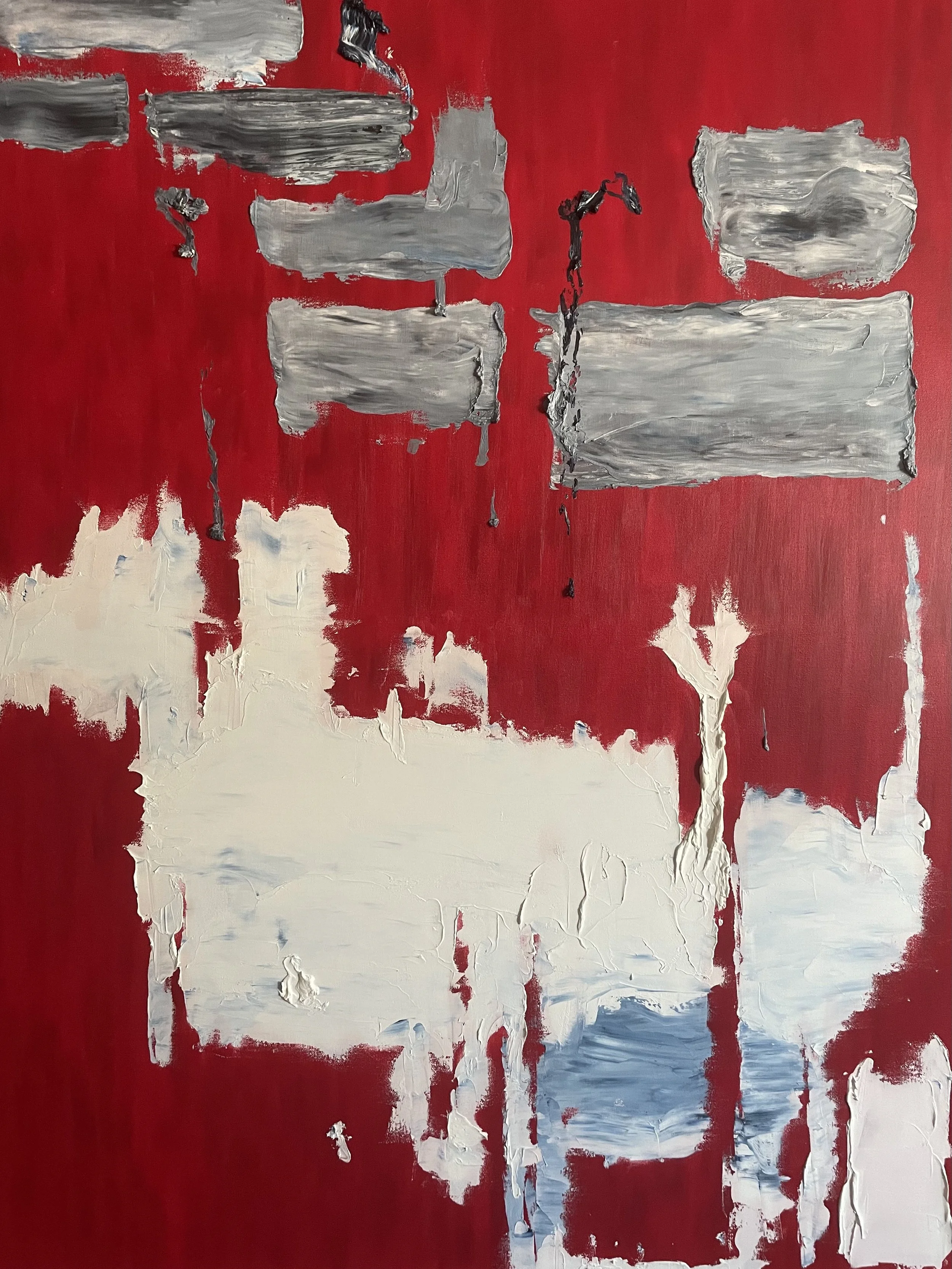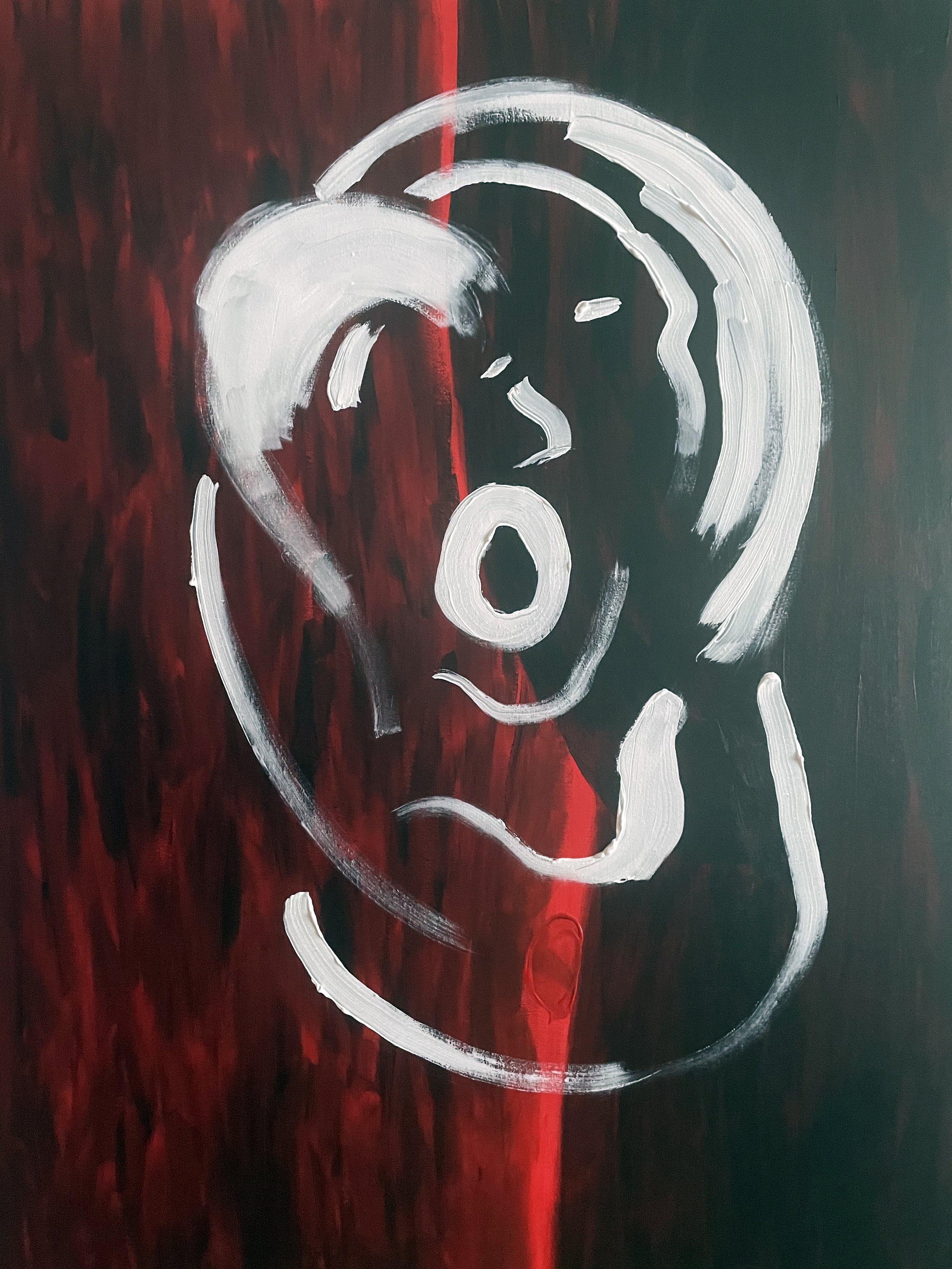Zeb Lund
Zeb Lund’s artworks stand at the intersection of architectural precision, raw emotion, and the boundless explorations of the human condition. His artistic narrative combines profound philosophical inquiry with an unrestrained experimental approach, making his body of work an evocative contribution to the contemporary art scene. Drawing from his architectural training, Lund’s works reflect a fascination with space, time, and ruin, yet transcend technicalities to delve deeply into human experience, emotion, and existential observation.
Lund’s art consistently returns to themes of decay and rebirth. His architectural background informs his fascination with ruins—not merely as structures, but as symbols of transience and resilience. This perspective recalls the sensibilities of early 20th-century surrealist Giorgio de Chirico, who similarly explored architectural spaces as vessels for metaphysical pondering. While de Chirico imbued empty plazas with enigmatic dread, Lund’s approach feels more organic, almost celebratory of humanity’s imperfections and our ability to reconstruct meaning from the broken.
The textural depth of his "Impressions" series speaks to both destruction and renewal. With expressive, almost violent brushstrokes, Lund invokes a dialogue about fragmentation—yet the fragments themselves coalesce into compositions that feel alive. The interplay of contrasting hues and textures, particularly in works like "Impressions, 2021," suggests a cyclical rhythm where disorder begets creation.
Zeb Lund’s talent shines in his ability to treat material as narrative. His pieces often incorporate layers of texture, each deliberate stroke or slash offering a physical manifestation of abstract ideas. For instance, the "Fontana Studies," which pay homage to Lucio Fontana, are compelling meditations on space and void. Fontana’s influence is evident in the deliberate slashes that interrupt the canvas, but Lund transforms this vocabulary into something deeply personal. The "Fontana Study: Red, 2019" exemplifies this, with its stark crimson field pierced by a single linear incision. This gesture transcends homage; it is Lund’s exploration of the tension between destruction and beauty, between a clean architectural line and a raw, visceral gesture.
Lund’s use of bold colors—such as the visceral red in his "Fontana" series or the icy blues of "Blue Study: S, 2019"—carries emotional weight, evoking the timeless struggle between human passion and introspection. These works, striking in their simplicity, resonate with a universal yearning for balance: between chaos and order, energy and stillness.
Zeb Lund’s approach to expression, particularly in his self-portrait series, is both haunting and intimate. These works reveal the artist’s profound engagement with identity and vulnerability. "Self-Portrait, 2011," uses stark, almost skeletal forms to evoke the fragility of the human spirit. By 2021, Lund’s self-portraits have evolved into layered, more abstract compositions that play with light, shadow, and ambiguity, as seen in "Self-Portrait, 02, 2021." The progression across these works demonstrates his ongoing investigation into the multiplicity of the self, echoing the existential musings of Francis Bacon while retaining Lund’s unique visual lexicon.
These portraits are more than representations; they are emotional landscapes. The fragmented faces, textured with both fine details and chaotic strokes, suggest a process of continual becoming. For Lund, identity is not static—it is a space to explore, a ruin to rebuild endlessly.
In a world increasingly dominated by fleeting digital images, Zeb Lund’s work serves as a counterpoint. His canvases invite viewers to linger, to confront the rawness of human existence and its inherent contradictions. By exploring ruins and fractures—whether physical, emotional, or societal—Lund encourages reflection on the impermanence of life and the resilience of the human spirit. In this sense, his art is deeply therapeutic, offering society a visual language to process collective anxieties and hopes.
Lund’s layered, tactile approach challenges the flatness of modern visual culture. His textured works demand engagement not only with the eyes but with the imagination, evoking sensations of touch, movement, and memory. This is especially poignant in the “Impressions” series, where the layers of paint feel almost sculptural, begging the viewer to consider the physicality of creation.
Zeb Lund’s art is not only significant for its emotional depth but also for its intellectual rigor. His ability to merge architectural precision with raw, abstract forms places him among contemporary artists who are redefining the boundaries of artistic expression. Like Anselm Kiefer, Lund transforms heavy, material-based works into meditations on history, memory, and existence. Yet while Kiefer often leans into the monumental and historical, Lund’s focus feels intensely personal and immediate, making his work all the more relatable.
In his most recent series, such as "Self-Portrait, 2021" and "Impressions, 2022," Lund explores the boundaries between figuration and abstraction. These pieces reveal his refusal to be confined by stylistic trends, instead prioritizing authenticity and experimentation. His works resonate with a timeless quality, yet are undeniably products of our contemporary moment—a moment characterized by uncertainty, fragmentation, and resilience.
Comparisons to past figures like Fontana, de Chirico, and Bacon serve not to diminish Lund’s originality but to place him within a lineage of artists who dare to probe life’s deepest questions. Zeb Lund builds upon this legacy with a distinct voice, one rooted in the language of space, time, and human experience.
Zeb Lund’s art is a gift to the contemporary art scene and society at large. It offers us a mirror to confront our vulnerabilities, a canvas to imagine renewal, and a space to linger in the beauty of imperfection. His talent lies not only in his technical skill but in his willingness to bare his soul, to invite viewers into his philosophical and emotional landscapes. Zeb Lund is, without question, a vital voice in contemporary art—a voice that will resonate for years to come.
Zeb Lund's body of work, executed entirely in oil on canvas, represents a unique contribution to the contemporary art world, offering profound emotional and intellectual engagement that is both deeply personal and universally resonant. His use of oil paints, with their unparalleled richness and textural versatility, imbues his works with a tangible depth that speaks to the complexities of the human condition. In an age where digital media dominates the visual landscape, Lund’s commitment to this traditional medium sets him apart, serving as both a homage to the history of art and a reclamation of its enduring relevance.
What makes Zeb Lund’s art so distinctive is his ability to weave multiple narratives into his works without sacrificing the immediacy of their impact. His training as an architect brings a structural rigor to his compositions, yet his brushwork conveys an emotive spontaneity that defies simple categorization. This balance between control and chaos, precision and instinct, is what makes his art so compelling. Each painting feels like a world unto itself—a landscape of thought, emotion, and philosophy that rewards both intellectual contemplation and visceral reaction.
Lund’s works stand out in the contemporary art scene because they resist the lure of superficiality. While many artists focus on creating works that are instantly digestible or tailored for mass consumption, Lund demands more from his audience. His layered compositions, intricate textures, and nuanced use of color require time, patience, and reflection. This insistence on depth over immediacy gives his works a timeless quality, ensuring their relevance not only in the present but for future generations.
In a world fraught with uncertainty and disconnection, Zeb Lund’s art offers a much-needed space for reflection and dialogue. His exploration of ruins, identity, and the passage of time resonates deeply in a society grappling with questions of sustainability, impermanence, and self-definition. Lund’s paintings remind us of the value of introspection, encouraging viewers to confront their vulnerabilities and find strength in their imperfections. In this way, his art is not only aesthetically powerful but also socially significant—it fosters a sense of connection in an era where isolation often prevails.
Lund’s focus on themes of fragmentation and renewal aligns with broader societal concerns about resilience in the face of adversity. His works suggest that beauty can be found in brokenness, that creation is an ongoing process, and that the act of rebuilding—whether personal, societal, or environmental—is itself a form of hope. By engaging with these universal themes, Lund’s art transcends cultural and geographical boundaries, speaking to the shared human experience.
Zeb Lund occupies a distinctive place in the contemporary art market, where his works are sought after not just for their visual appeal but for their intellectual depth and emotional resonance. In a market often driven by trends and quick returns, Lund’s commitment to authenticity and philosophical inquiry makes his art a rarity. Collectors and institutions value his works for their ability to bridge the gap between aesthetic beauty and conceptual rigor, positioning him as both a critical and commercial success.
His refusal to conform to market expectations—choosing instead to pursue his artistic vision with integrity—further elevates his status. This uncompromising approach has earned him the respect of critics, curators, and collectors alike, solidifying his reputation as an artist whose work will endure beyond the fluctuations of the art market. Lund’s paintings are not just investments; they are cultural artifacts, pieces that hold the power to shape the discourse around contemporary art for years to come.
His art is a reminder that, in an age of instant gratification, there is still immense value in taking time to create—and to experience—something meaningful. Lund’s paintings challenge viewers to slow down, to look closely, and to engage with the world on a deeper level. This is perhaps his greatest gift: the ability to transform paint and canvas into portals for self-discovery and connection.
Zeb Lund is a singular talent, a contemporary artist whose work defies easy categorization while leaving an indelible mark on the art world. His paintings, all rendered in oil on canvas, are at once deeply personal and universally resonant, offering viewers a space to confront the complexities of life with honesty and courage. In a market often dominated by fleeting trends, Lund’s art stands as a testament to the enduring power of authenticity, craftsmanship, and intellectual depth.
Through his explorations of space, time, and the essence of the human condition, Lund has carved out a unique place in the contemporary art scene—one that will only grow in significance as society continues to grapple with questions of identity, impermanence, and renewal. His ability to balance architectural precision with emotional rawness, to bridge the personal and the universal, and to create works that are both aesthetically and philosophically rich, cements his place as one of the most important artists of our time.
Zeb Lund’s art is not just a reflection of the present moment—it is a call to engage more deeply with ourselves, with one another, and with the world around us. For this reason, his work will remain a vital and enduring contribution to the cultural landscape.
By Marta Puig
Editor Contemporary Art Curator Magazine
Blochs, 2021, Oil on Canvas, 75 x 90cm
Blue Study, 2019, Acrylic on Canvas, 20 x 20cm
Blue Study, 2019, Acrylic on Canvas, 20 x 20cm
Fontana Study, 2020, Acrylic on (cut) Canvas, 45 x 60cm
Fontana Study, 2019, Acrylic on (cut) Canvas, 45 x 60cm
Impressions, 2021, Oil on Canvas, 20 x 90cm
Impressions, 2022, Oil on Canvas, 20 x 60cm
Self Portrait, 2021 Acrylic on Canvas, 75 x 90cm
Self Portrait, 2021 Acrylic on Canvas, 75 x 90cm
Self Portrait, 2011, Mixed Media, 30 x 45cm













